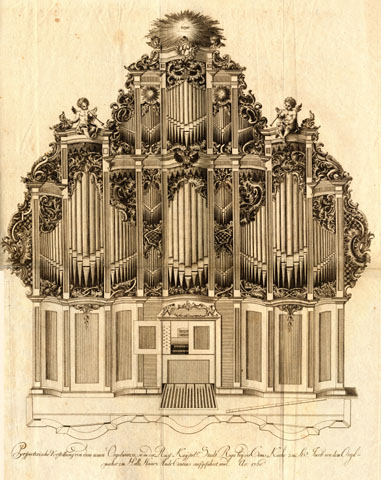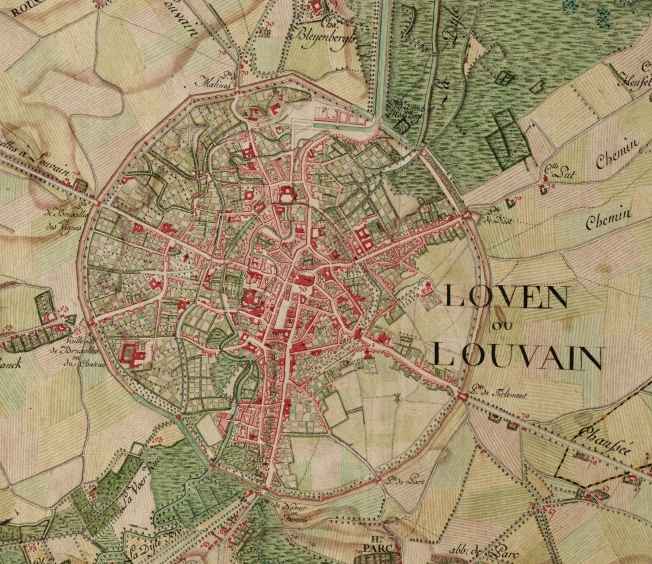|
Heinrich Andreas Contius
Heinrich Andreas Contius, also Cuntius (1708 – 1795 in Valmiera, Livonia) is considered the most important organ builder in the Baltic States in the 18th century. Life Contius was born in 1708 as the son of the organ builder Christoph Cuntzius in Halle an der Saale, Duchy of Magdeburg. In 1732 he is recorded as a journeyman of Joachim Wagner. He initially had his own workshop in Altenburg. From 1736/37, Contius worked in Halle and the surrounding area. From 1748, a letter of recommendation from Johann Sebastian Bach in his favour for the planned new organ building in the is known, then a letter to Contius himself. Den Auftrag erhielt er aber nicht. In 1760, Contius moved to Riga in Courland, where he built an organ for the St. James's Cathedral, Riga.Imants Lancmanis: ''Libau. Eine baltische Hafenstadt zwischen Barock und Klassizismus''. Böhlau, Cologne 2007, , . He then worked in Tallinn in Estonia and became the leading organ builder there. In 1771, he returned to ... [...More Info...] [...Related Items...] OR: [Wikipedia] [Google] [Baidu] |
Valmiera
Valmiera (; german: link=no, Wolmar; pl, Wolmar see other names) is the largest city of the historical Vidzeme region, Latvia, with a total area of . As of 2002, Valmiera had a population of 27,323, and in 2020 – 24 879. It is a state city the seat of Valmiera Municipality. Valmiera lies at the crossroads of several important roads, to the north-east from Riga, the capital of Latvia, and south of the border with Estonia. Valmiera lies on both banks of the Gauja River. Names and etymology The name was derived from the Old German given name or the Slavic name . The town may have been named after the kniaz of the Principality of Pskov Vladimir Mstislavich who became a vassal of Albert of Riga in 1212 and for a short time was a vogt of Tālava, Ydumea and Autīne. Another version, it may have been named after the King of Denmark Valdemar II who allied with the Livonian Brothers of the Sword in Livonian Crusade. In the second half of 13th century Livonian Ord ... [...More Info...] [...Related Items...] OR: [Wikipedia] [Google] [Baidu] |
Holy Trinity Cathedral, Liepāja
Liepāja Holy Trinity Lutheran Cathedral ( lv, Liepājas Svētās Trīsvienības katedrāle) is a historical Lutheran cathedral in Liepāja, Latvia. It is the seat of the Bishop of Liepāja, and principal church of the Diocese of Liepāja. History The foundation stone of the church was laid in 1742 and on December 5, 1758, the church was solemnly consecrated. The church interior and exterior architecture is built in the late baroque style with classic features. The cathedral interior is characterized by its Rococo features and luxurious furnishings with wood carvings and gold plating. The altar is 13 metres high and the cathedral is particularly notable for its organ with 131 stops, 4 manuals and over 7000 pipes, making it the largest mechanical organ in the world until 1968. It was the first large mechanical pipe organ in Latvia and was built by Henrich Andreas Concius in 1779. In 1865–1866, the building underwent its first major reconstruction – the original draft tower ... [...More Info...] [...Related Items...] OR: [Wikipedia] [Google] [Baidu] |
Sint Michiel (Löwen)
Sint Michiel (also Boca Samí) is a former fishing village in Willemstad lying at the south end of Bullenbaai bay on the west coast of Curaçao Curaçao ( ; ; pap, Kòrsou, ), officially the Country of Curaçao ( nl, Land Curaçao; pap, Pais Kòrsou), is a Lesser Antilles island country in the southern Caribbean Sea and the Dutch Caribbean region, about north of the Venezuela coast .... It is located to the northwest of the island's city centre. Overview The St. Michiel Bay is locally known as "Boca Samí" and is situated between the much smaller Blue Bay and Vaersenbaai. It is named after Saint Michael. Vaersen Bay used to be the Curaçao Police recreational facility. It is now the beach club Kokomo Beach Curacao. The bay was once defended by two WIC forts. The ruins of the main fort are still visible. These forts provided protection from French pirates and the British Navy though they were occupied by both in the 18th and early 19th Century. The settlement sta ... [...More Info...] [...Related Items...] OR: [Wikipedia] [Google] [Baidu] |
Barnim Grüneberg
Barnim () is a district in Brandenburg, Germany. It is bounded by (from the east and clockwise) Poland, the district of Märkisch-Oderland, the city state of Berlin and the districts of Oberhavel and Uckermark. History The name "Barnim" emerged in the 13th century and was applied to a large forest region east of the Havel and north of the Spree on the homonymous plateau, where noblemen used to hunt. The present district is roughly identical with, but somewhat smaller than this historical region. The district was established in 1993 by merging the former districts of Bernau and Eberswalde. Geography Barnim extends from the Oder River to the outskirts of Berlin. The Oder River forms the eastern border. From here the Oder Havel Canal (connecting Oder and Havel) and the historical Finow Canal lead westwards to Eberswalde and beyond. The portions north of these artificial waterways are called Schorfheide The Schorfheide-Chorin Biosphere Reserve, often shortened ... [...More Info...] [...Related Items...] OR: [Wikipedia] [Google] [Baidu] |
BM07192ABCDm
BM or bm may refer to: Arts and entertainment Music * BM (rapper), born Matthew Kim, a Korean-American rapper * ''BM'' (album), a 2008 Barbara Morgenstern album * B minor, a musical chord (Bm) * Bachelor of Music, an academic degree * Beautiful music, a radio format * Black metal, a genre of music Other uses in arts and entertainment * Bashir Mirza, a Pakistani painter * BM or "Bad Manners" in video gaming, cf. glossary of video game terms#BM Business Business terminology * Brick and mortar or B&M Businesses * Birmingham Midshires, a division of the Bank of Scotland * Bolinder-Munktell, a Swedish tractor manufacturer, now part of Volvo * Bolliger & Mabillard, B&M, a Swiss roller coaster manufacturer * Boston and Maine Corporation, B&M, a former US railway company * British Midland International, former airline rebranded bmi ** BMI Regional, IATA airline code Science and technology Health and medicine * Bachelor of Medicine, an academic degree * Bacteria ... [...More Info...] [...Related Items...] OR: [Wikipedia] [Google] [Baidu] |
Merseburg Cathedral
Merseburg Cathedral (german: Merseburger Dom) is the proto-cathedral of the former Bishopric of Merseburg in Merseburg, Germany. The mostly Gothic church is considered an artistic and historical highlight in southern Saxony-Anhalt. History Background Merseburg acquired importance beyond the immediate region in the 10th century when it came to King Heinrich I (Henry I) by marriage. He built a ''Kaiserpfalz'' there overlooking the Saale and founded a church next to it, consecrated in 919. His son and successor, Otto I swore an oath on 10 August 955 to establish a diocese at Merseburg if God would grant him victory at the upcoming Battle of Lechfeld. In 968, the Diocese of Merseburg was established but dissolved in 981. In 1004 it was reestablished by King Heinrich II (Henry II). Early Romanesque cathedral Construction of the early Romanesque cathedral was begun by Bishop Thietmar of Merseburg in 1015. It was consecrated on 1 October 1021 in the presence of Emperor Heinrich II ... [...More Info...] [...Related Items...] OR: [Wikipedia] [Google] [Baidu] |
Merseburg
Merseburg () is a town in central Germany in southern Saxony-Anhalt, situated on the river Saale, and approximately 14 km south of Halle (Saale) and 30 km west of Leipzig. It is the capital of the Saalekreis district. It had a diocese founded by Archbishop Adalbert of Magdeburg. The University of Merseburg is located within the town. Merseburg has around 33,000 inhabitants. Names * cs, Merseburk, Meziboř * french: Mersebourg * german: Merseburg * la, Merseburga * pl, Międzybórz * wen, Mjezybor Geography The town Merseburg consists of Merseburg proper and the following four ''Ortschaften'' or municipal divisions:Hauptsatzung der Stadt Merseburg § 15, April 2019. * [...More Info...] [...Related Items...] OR: [Wikipedia] [Google] [Baidu] |
Wallwitz
Wallwitz is a village and a former municipality in the Jerichower Land district, in Saxony-Anhalt, Germany. Since 1 January 2009, it is part of the town Möckern. Former municipalities in Saxony-Anhalt Möckern {{JerichowerLand-geo-stub ... [...More Info...] [...Related Items...] OR: [Wikipedia] [Google] [Baidu] |
Leuven
Leuven (, ) or Louvain (, , ; german: link=no, Löwen ) is the capital and largest City status in Belgium, city of the Provinces of Belgium, province of Flemish Brabant in the Flemish Region of Belgium. It is located about east of Brussels. The municipality itself comprises the historic city and the deelgemeente, former neighbouring municipalities of Heverlee, Kessel-Lo, a part of Korbeek-Lo, Wilsele and Wijgmaal. It is the eighth largest city in Belgium, with more than 100,244 inhabitants. KU Leuven, Belgium's largest university, has its flagship campus in Leuven, which has been a university city since 1425. This makes it the oldest university city in the Low Countries. The city is home of the headquarters of Anheuser-Busch InBev, the world's largest beer brewer and sixth-largest fast-moving consumer goods company. History Middle Ages The earliest mention of Leuven (''Loven'') dates from 891, when a Viking army was defeated by the Franks, Frankish king Arnulf of Carinthia ... [...More Info...] [...Related Items...] OR: [Wikipedia] [Google] [Baidu] |
Liepāja
Liepāja (; liv, Līepõ; see other names) is a state city in western Latvia, located on the Baltic Sea. It is the largest-city in the Kurzeme Region and the third-largest city in the country after Riga and Daugavpils. It is an important ice-free port. The population in 2020 was 68,535 people. In the 19th and early 20th century, it was a favourite place for sea-bathers and travellers, with the town boasting a fine park, many pretty gardens and a theatre. Liepāja is however known throughout Latvia as "City where the wind is born", likely because of the constant sea breeze. A song of the same name ( lv, "Pilsētā, kurā piedzimst vējš") was composed by Imants Kalniņš and has become the anthem of the city. Its reputation as the windiest city in Latvia was strengthened with the construction of the largest wind farm in the nation (33 Enercon wind turbines) nearby. The coat of arms of Liepāja was adopted four days after the jurisdiction gained city rights on 18 March 16 ... [...More Info...] [...Related Items...] OR: [Wikipedia] [Google] [Baidu] |
Pipe Organ
The pipe organ is a musical instrument that produces sound by driving pressurized air (called ''wind'') through the organ pipes selected from a keyboard. Because each pipe produces a single pitch, the pipes are provided in sets called ''ranks'', each of which has a common timbre and volume throughout the keyboard compass. Most organs have many ranks of pipes of differing timbre, pitch, and volume that the player can employ singly or in combination through the use of controls called stops. A pipe organ has one or more keyboards (called '' manuals'') played by the hands, and a pedal clavier played by the feet; each keyboard controls its own division, or group of stops. The keyboard(s), pedalboard, and stops are housed in the organ's ''console''. The organ's continuous supply of wind allows it to sustain notes for as long as the corresponding keys are pressed, unlike the piano and harpsichord whose sound begins to dissipate immediately after a key is depressed. The smallest ... [...More Info...] [...Related Items...] OR: [Wikipedia] [Google] [Baidu] |






